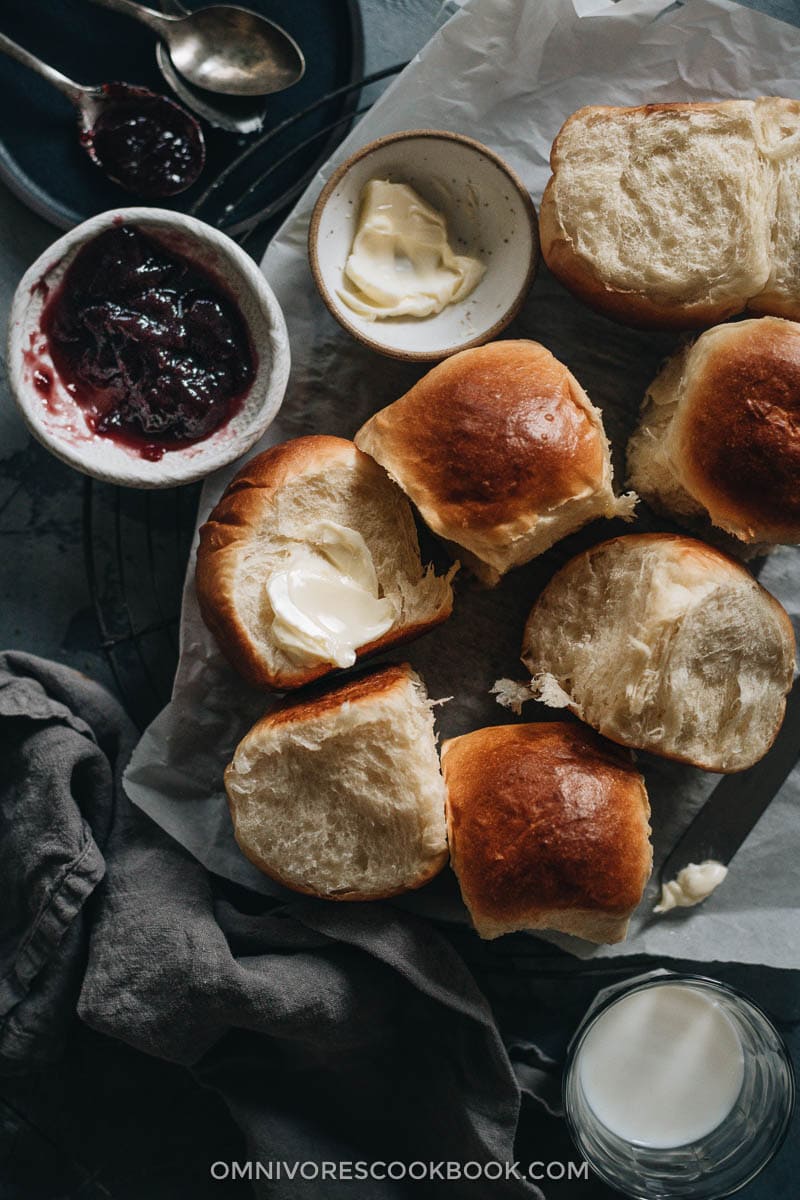
I had the softest bread when I was living in Japan, back when I was in school. Not just the freshly baked bread from the bakery, but even the mass-produced sliced white bread in Japan has a super fluffy and fine texture. You could easily smash a 1” (2 cm) thick piece of bread until paper-thin and it would still bounce back. My taste for milk bread heightened after I enjoyed it for two years in Japan. Fast forward to 10 years later, I still crave that soft bread slathered with a dollop of butter and jam
Now that the weather has turned cold and the holiday season is around the corner, I want to bring these soft and fluffy bread rolls to your Thanksgiving dinner table. My goal was to develop a very easy recipe that requires minimal hands-on time and yields the best result. After much testing and refinement, I finally settled on this easy milk bread roll recipe.
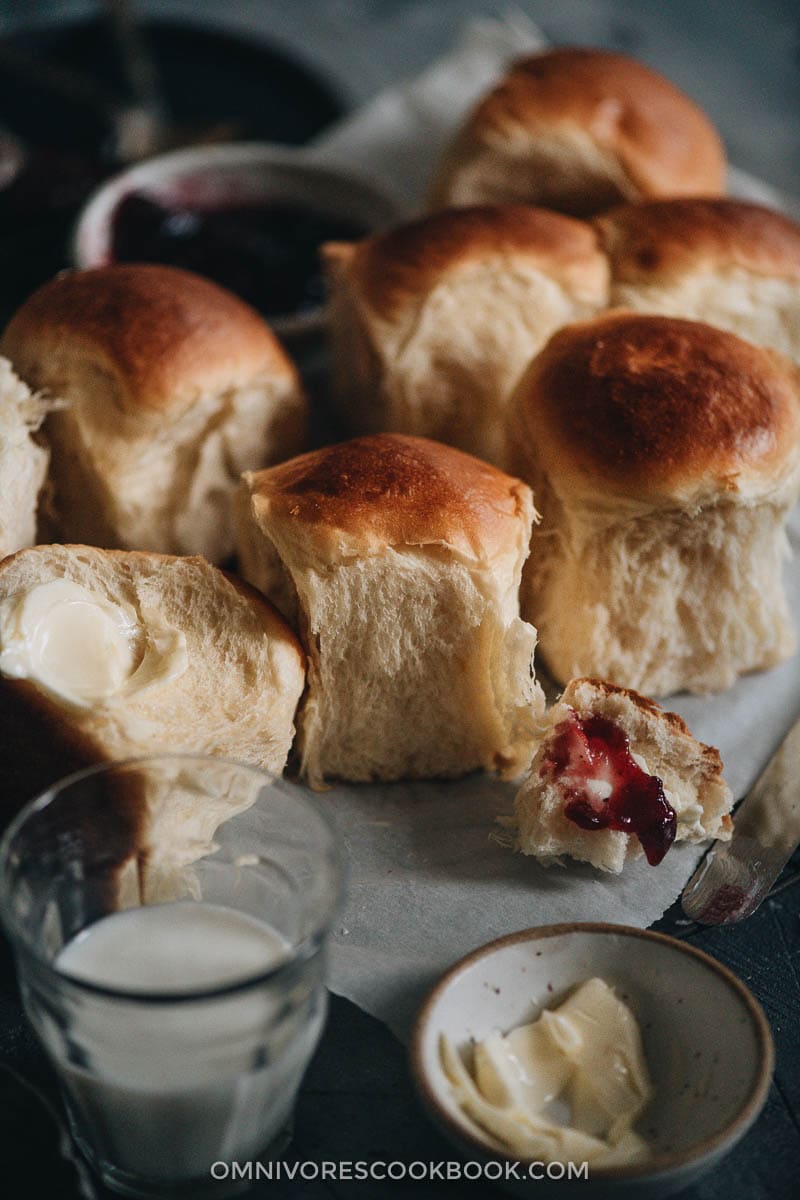
Why this recipe
- Easy ingredients. It’s likely that you have most of them in your pantry and you can find everything in regular grocery store.
- The recipe doesn’t require a starter (a.k.a Tangzhong). This makes the process easier.
- Let the mixer do all the work. The recipe requires minimal hands-on time with the dough and the active prep time is only about 20 minutes.
- Outstanding result with a soft, springy texture and tiny air bubbles.
- Foolproof process that any beginner baker can easily follow.
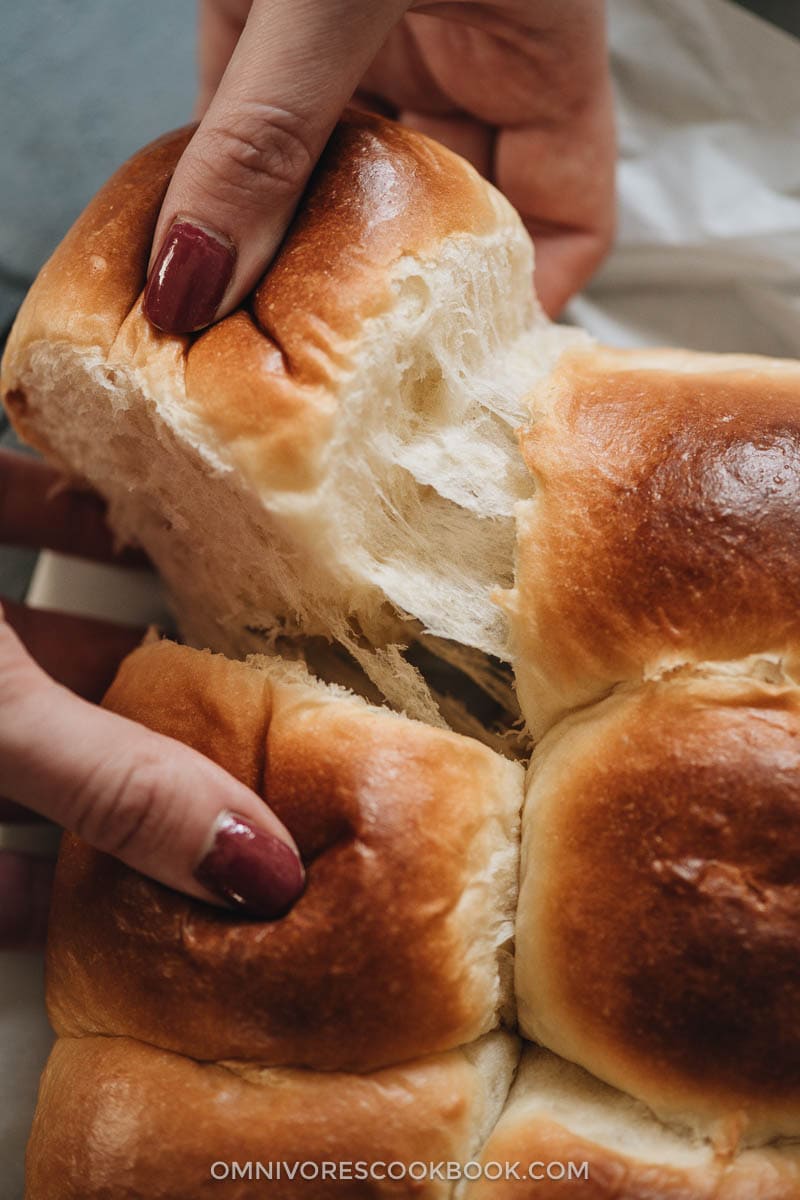
Milk bread roll ingredients
You only need eight ingredients for the milk bread dough:
- Egg
- Bread flour
- Yeast
- Sugar and salt
- Whole milk
- Sweetened condensed milk
- Butter
We tested multiple formulas with different combinations such as milk, heavy cream etc. We finally settled on this one using condensed milk. It gives the bread a sweetness like the bread from an Asian bakery.
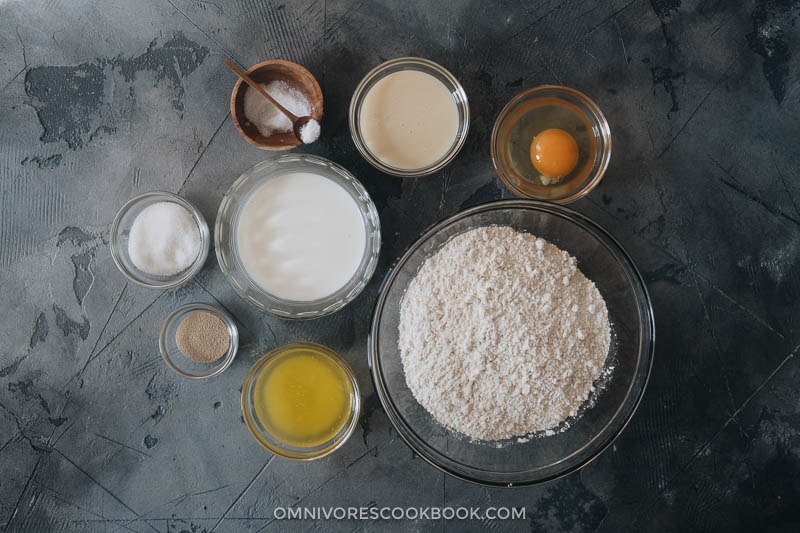
How to make milk bread rolls
1. Prepare the dough – 1st rise
The recipe starts by activating the yeast. Even though you can get away without this step, I feel that it’s quite necessary to make sure your yeast is fresh and will work properly. So you don’t end up wasting a lot of time and ingredients with expired yeast.
Once you mix the ingredients together, let the dough mass sit for 20 minutes to let the yeast do its work.
Then knead it with a mixer until the dough is smooth. Once the dough is ready, it will be very wet and a bit sticky, but you should be able to handle it with your hands.
Rest the dough for about 1 hour.
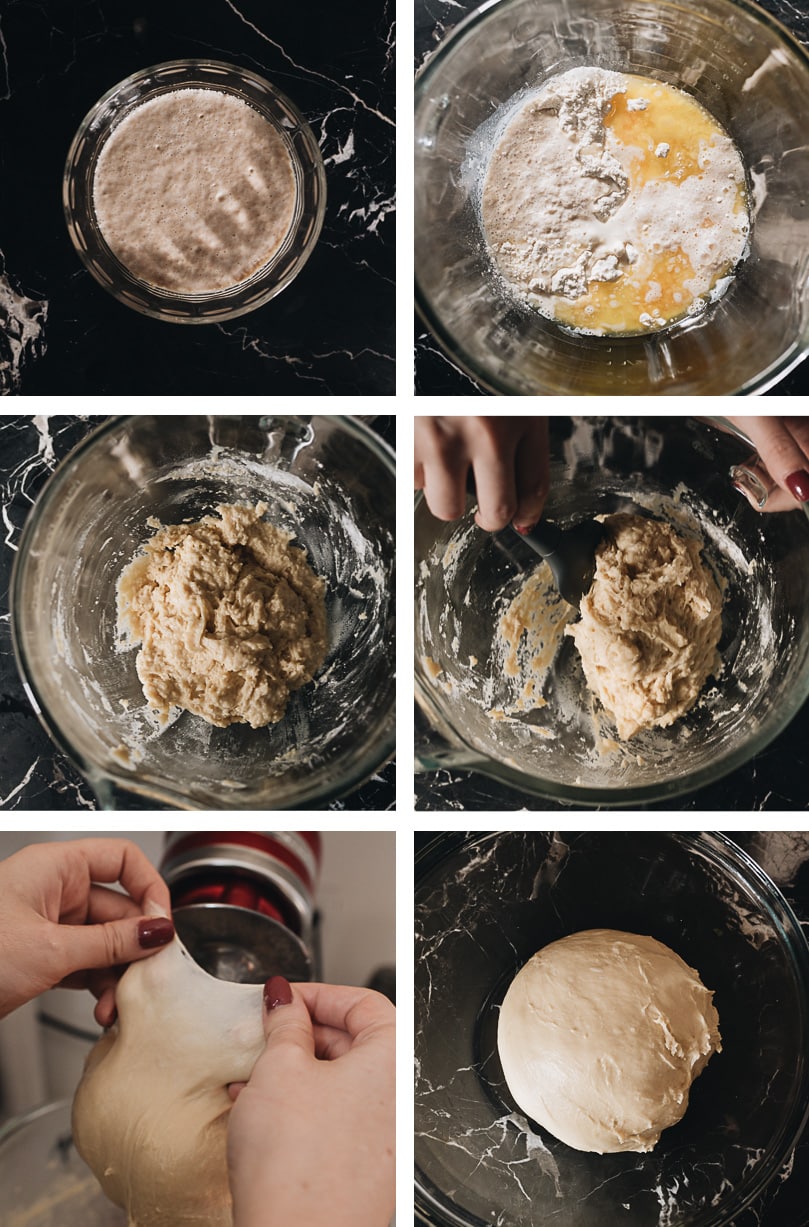
3. Assemble – 2nd rise
The dough will double in size once rested, as well as become springy and less sticky. You’ll need to punch the dough to squeeze out the air, so the end result will have an even texture.
Divide the dough into nine even pieces. To ensure even baking and consistent size, you can measure out the dough balls with a scale.
Once you’ve placed the dough balls onto the baking sheet, let the dough rise again, for 35 to 45 minutes.
Then brush a very thin layer of milk onto the bread so it will yield a beautiful golden brown color after baking. We chose to use a milk wash instead of an egg wash, so the bread rolls’ outer texture would be similar to that of traditional dinner rolls.
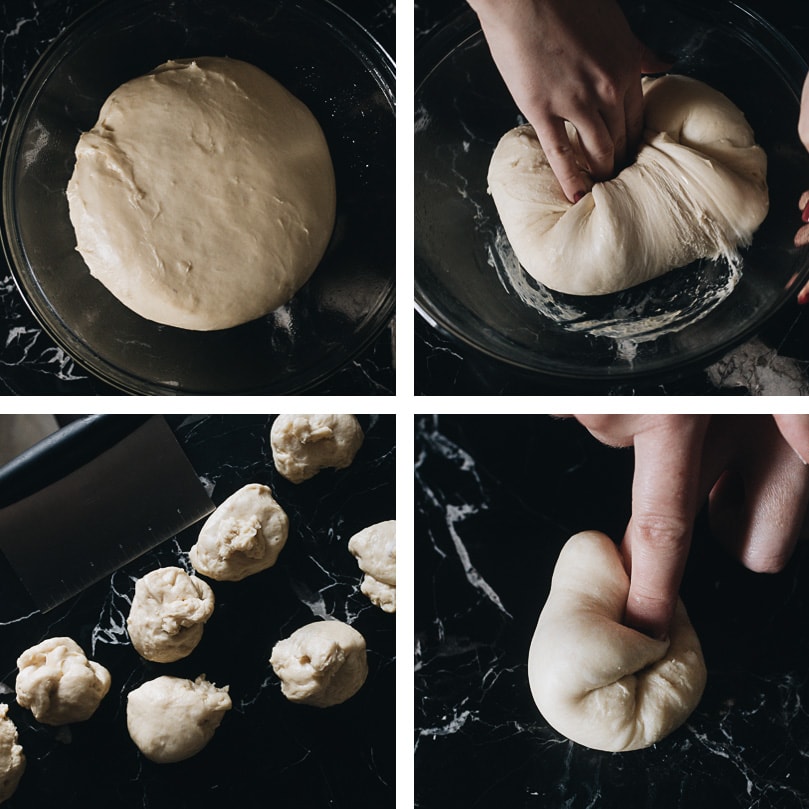
4. Bake and serve
The rest is easy. Simply bake the milk bread rolls at 350° F (176° C) for 20 to 25 minutes until golden brown.
The dinner rolls will come out fluffy, airy, and slightly sweet. When you pull them apart, you’ll see the stringy texture with even, tiny air bubbles.
These milk bread rolls taste best when fresh. But the best part of this recipe is, you can store them at room temperature for a day and they will stay soft and moist.
You can store the bread in the freezer for longer storage, but it’s very unlikely they will last that long!
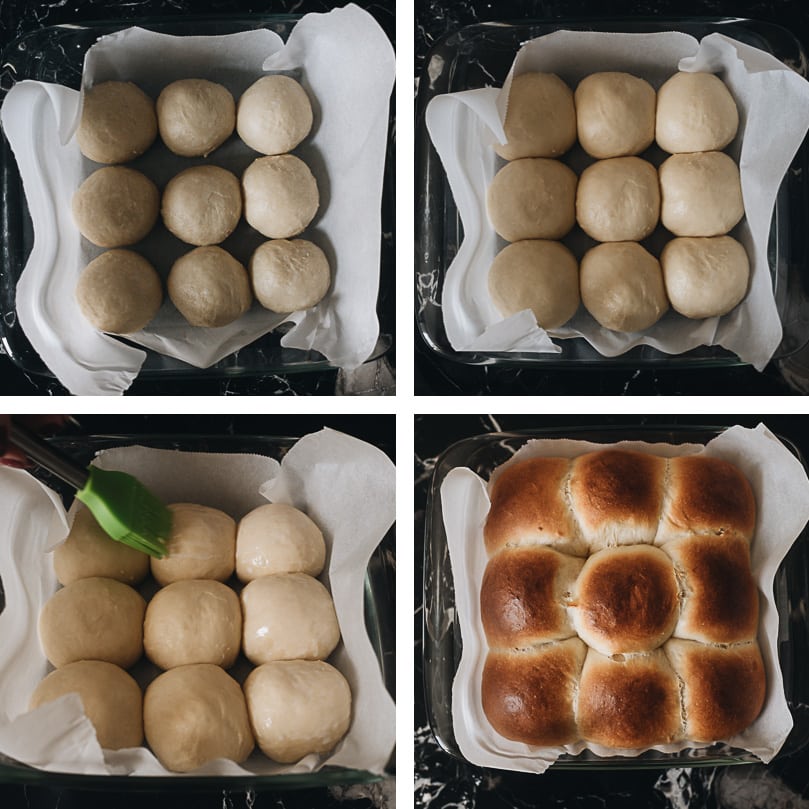
Afterthoughts
It’s true that it takes a bit of time and patience to make milk bread rolls at home. But this recipe is so simple that it can totally become one of your everyday recipes. These rolls taste great by themselves, but you can use your favorite spread on them, such as butter, jam, or peanut butter.
The recipe is also perfect for the holiday season and any dinner party, because it requires very little active cooking time. You can prepare them in advance and they hold up well.
I hope you enjoy them as much as I do!
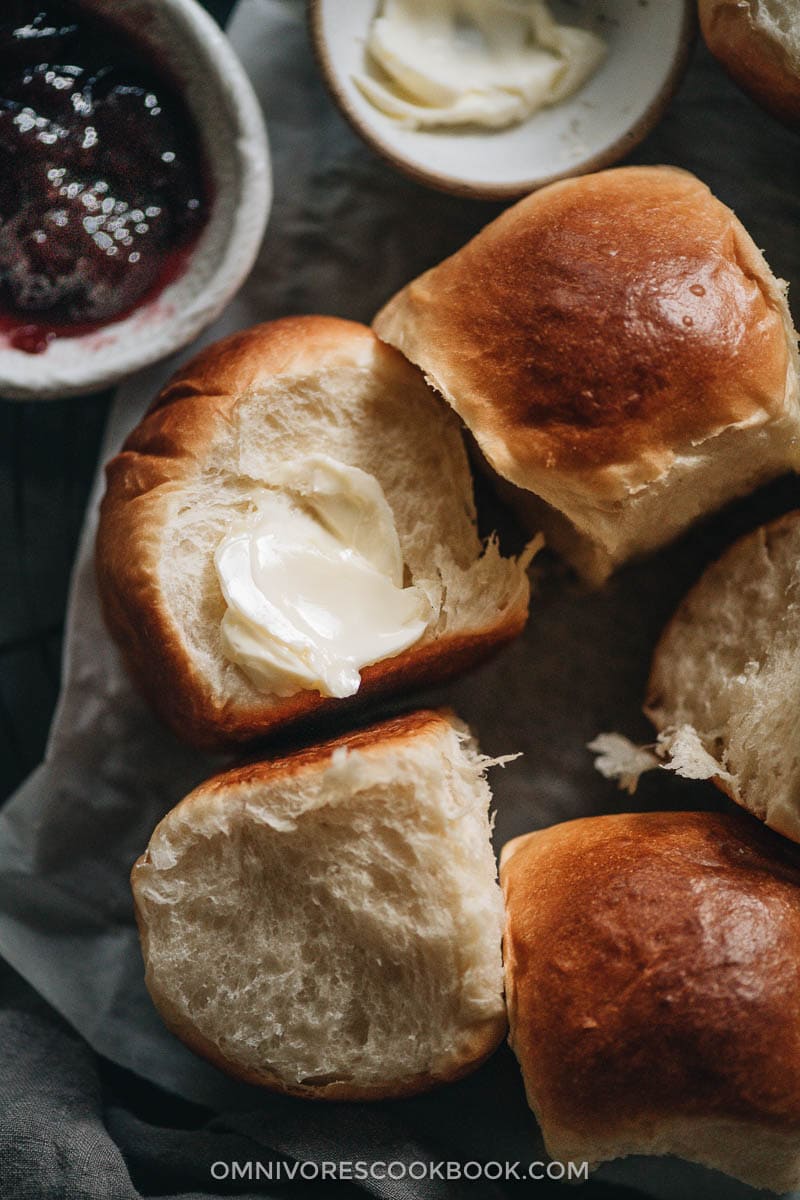
Serve these milk bread rolls with
- Duck de Marietta (The Best Slow Roast Duck)
- The Best Cantonese Roast Chicken
- Curried Vegan Green Bean Casserole
- Asian Thanksgiving Recipes
- Slow Cooker Honey Garlic Chicken Sliders
Chinese Cooking Made Easy
Are you new to this website? This free email series is a great place to start. I’ll walk you through a few of my most popular recipes and show you how and why they work. You’ll quickly start to cook better Chinese food in your own kitchen.
Watch video
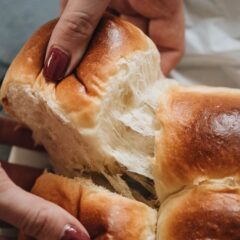
Easy Milk Bread Rolls
Ingredients
- 2 1/2 cups bread flour
- 1/2 cup whole milk , and extra for brushing onto the bread
- 2 teaspoons active dry yeast
- 2 1/2 tablespoons sugar
- 1 teaspoon salt
- 1/4 cup sweetened condensed milk
- 4 tablespoons unsalted butter , melted
- 1 large egg
Instructions
1st rise
- Add the milk into a small bowl and warm to approximately 100-110°F (38°C), about 30 seconds in the microwave. The milk should be warm, just a bit above body temperature. Add a pinch of sugar and the active dry yeast. Let sit for 5 minutes so the yeast will activate.
- While the yeast activates, add the rest of the ingredients into your mixer bowl.
- Once the yeast is activated, you should see bubbles on the surface of the mixture. Pour it into the mixer bowl. Mix with a spatula until the dough just comes together. Cover with plastic wrap and let rest for 20 minutes.
- Install the dough hook on your mixer (I used a KitchenAid). Start at low speed, then gradually increase to setting 8 out of 10. Knead for 10 to 12 minutes, until the dough is very smooth. Stop the mixer in the middle and scrape the dough from the sides of the bowl. Test the dough by pulling a piece of it using both of your hands. It should stretch into a very thin and translucent sheet. The dough should be wet and a bit sticky.
- Grease a big bowl with a thin layer of oil. Place the dough into the bowl. Cover with plastic wrap. Let rise until the dough doubles in size, about 1 hour.
2nd rise
- Line a 9” x 9” (23cm x 23 cm) baking pan with parchment paper.
- Punch the air out of the dough. Transfer it onto a lightly oiled working surface. Divide the dough into 9 even pieces by cutting it into 3 even strips, then further cutting each strip into 3 small pieces. Each piece of dough should weigh 68 to 70 grams.
- Shape the dough one piece at a time. Tuck the dough onto itself by pinching the dough from all sides into the center using your fingers, creating a round shape. Then roll the dough in a circular motion with your palm against the table, until it forms a round ball. Place the dough balls onto the parchment paper, evenly spaced, in a 3-by-3 array.
- Cover the baking pan with plastic wrap. Let rest again for another 35 to 45 minutes, until the size has doubled.
Bake
- Preheat the oven to 350° F (176° C) while resting the shaped bread rolls.
- Right before baking, gently brush a thin layer of milk onto the tops of the bread rolls.
- Bake the milk bread rolls on the middle rack for 20 to 25 minutes, until the top turns golden brown. You can also test the doneness by inserting an instant-read thermometer into the middle of the center bun. It should register at least 190°F.
- Let the bread rest in the pan for 5 minutes, then transfer it onto a cooling rack.
- Serve warm or at room temperature.
Store
- Once the milk bread rolls have cooled completely, you can store them in an airtight container on your kitchen counter for up to 2 days. The rolls will stay very soft at room temperature. You can also warm them up in the microwave it for 10 seconds or leave them in a 350° F (176° C) oven to warm up before serving.
- For longer storage, place the dinner rolls in a ziplock bag, squeeze out as much air as possible, and store them in the freezer for up to a month. To reheat, bake the rolls at 350° F (176° C) without thawing, until warm throughout, 10 minutes or so.
Nutrition

Did you make this recipe?
I’d love to hear how it turned out for you! Please take a moment to leave a 5-star rating ⭐️ and share your thoughts in the comments further down the page. It really helps others discover the recipe too.
Lilja Walter is a part of the Omnivore’s Cookbook team and worked closely with Maggie to develop and test this recipe.

Brianna Tang
Would this recipe work with a hand held mixer or bread machine instead of a stand mixer? If so, which would be better?
Maggie
Brianna, I have never tried either but I think a bread machine will work better. Once you finished kneading in the bread machine, check the dough by stretching it. It’s ready if the dough can form a thin semi-transparent sheet without breaking apart. Then you can let it rise at room temperature and bake in the oven according to the recipe.
Lily
Hi!
Did you use salted or unsalted butter in this recipe?
Maggie
Hi Lily, this recipe calls unsalted butter.
Shelia King
Please help me! The flavor is great, but the rolls are too moist in the middle although I checked the temperature. Should I have made a larger (smaller rolls) quantity than 12?
Maggie
Hi Shelia, I think using a longer baking time will solve the issue. The temperature method might not be super reliable sometimes and I do combine with observing the bottom of the bread.
Aldana
Hello Maggie, I’m so looking forward to try your recipe, looks amazing!! I have one issue though.. How long should I knead it since I don’t have a mixing bowl? Thanks
Maggie
You need to hand knead the dough for quite a while, starting from 10 minutes but probably longer. To test the dough, you should able to stretch the dough into a semi transparent sheet without it breaking apart when it’s ready.
Gin
Def five star 😊
LC
Shld the dough is still sticky can I add some flour?
Maggie
It is a soft dough and a bit sticky after kneading, but shouldn’t be too sticky.
Gin
If I made a double batch do I need to increase the rising time too?
Maggie
Hi Gin, the rising time might increase a little bit but shouldn’t be doubled. Also your room temperature matters. So the best way is to check on the dough until the size doubles.
Luisa Talamayan
perfect…
Charity
Hi can I use all purpose flour instead of bread flour?
Maggie
Yes you can. The texture of the bread will come out a bit different but it should work.
Bertha
Such a hit. They are super soft and the house smells amazing
Melinda
Freaking delicious rolls! This is an easy must try recipe. I was looking for an milk roll recipe that didn’t require me to go out and buy a bunch of ingredients I’d only use once. I did use a scale to measure everything and it made a huge difference. I didn’t have whole milk so I used 2% plus a little half and half mixed in. Also, the recipe said to mix from low to high using the dough hook for 10 minutes which I didn’t do. I used a KitchenAid mixer on the 2 setting for 2 minutes and the 4 setting for 1 additional minute. It looked like it was mixed just enough. I made a double batch and baked all 18 rolls in a 9×13 pan lined with parchment paper. Baked for 28 mins and they came out perfect. Thank you Maggie!!!
Charli
Hi! Do you think I would possibly be able to fill these buns with a savoury filling like a take on a Char Sui style bun?
Maggie
Yes, definitely!
Ime
Hi Maggie!
Thanks for sharing your yummy milk bread recipe. It was easy to follow and it’s yummy
Herman Gersten
Maggie, this recipe is a winner, producing yummy rolls with a feathery soft interior and a delicately crunchy crust. Because I was out of regular milk, I substituted condensed milk, and I also used instant yeast and Caputo 00 Chef’s flour. I pulled them from the oven at 22 minutes, at which point they were nicely browned. I increased the dough weight to 80 grams, rolled the dough pieces into cylinders, and used a Wilton non-stick pan with openings for 8 mini breads. I think the condensed milk helped give the rolls a nice challah-like texture. You are quite right, by the way. They will all be gone by the end of the day tomorrow!
Kiesh
Excellent bread rolls. First rise went nowhere. After an hour and a half, I went ahead with shaping and the second rise. After another 90 minutes, I baked. They turned out soft and fluffy. I usually prefer the tangzhong method for all types of bread, but sometimes I just don’t want that extra step. These are excellent without it. Great smeared with sweetened condensed milk ….and sometimes a sprinkling of cinnamon.
Penny Ho
Hi, I’m sorry but may I know how many grams is one tablespoon butter?
Maggie
It should be about 14 grams.
Lei
I give this a 5 ⭐️. Firts time I tried your recipe and it went very well. Thank you for sharing your recipe 😌
Shar
Hi there,
After kneading on the stand mixer for 10 mins my dough was only slightly sticky, not wet. Should I add more liquid to it?
I did the reverse and mixed the flour and other ingredients into the yeast mixture. Could that be the reason why my dough was on the. Drye dryer side?
Maggie
The slightly sticky dough is actually the correct texture. The dough is not very wet when the kneading is done. If you’ve knead the dough in the mixer for a full 10 minutes, you shouldn’t add more liquid at that stage and should just go ahead and bake the bread.
Matt
Hello Maggie,
New to your site and loving it already. Going to try your pea shoots recipe tonight!
Question: Can these rolls be made without a stand mixer?
Maggie
Hi Matt, it’s going to be so much easier to make this recipe with a stand mixer. You can knead the dough without the mixer for sure, but it’s hard if you do not have bread-making experience. The dough is very wet. If you knead them on a surface, you need to grease the surface and use a dough scraper to fold the wet mass at the beginning until it develops gluten and possible to knead by hand. You also need to work with the dough with speed, since the dough will be very runny and sticky to handle.
Jenny
Hi,
Are these baked in a 9×13 or in a 9×9 or 8×8 square pan? In the photo the pan looks square, but in the directions it says to use a 9×13 pan.
Thanks!
Maggie
Hi Jenny, I used a 9×9 square pan. Sorry for the confusion! I just updated the recipe to reflect the correct pan size.
Barbarainnc
Just wanna make sure, it uses Sweetened Condensed Milk?? Can’t wait to try these. Nothing better than hot bread and butter. 😋😋😋
Maggie
I used sweetened condensed milk. Sorry for the confusion! Just updated the recipe and now it’s clear.
Bon
Hi Maggie, I’m looking forward to trying this recipe after many failed attempts at making Milk bread. I think my problem has been the temperature and place of which I allow my dough to rise. What is the idea temperature and place in your opinion? In the past I have preheated my oven to about 60-90deg Celsius (depending on the recipe) and everytime I get hard and stale like bread rolls. Would you have any advice on this? Thanks heaps! ^v^
Maggie
Hi Bon, the room temperature for dough rise can be quite flexible, so it’s more about judging the dough and adjust the rising time accordingly. I think the best temperature of dough rising is 80°F to 90°F (26°C to 32°C). I made this dish in the winter (put the dough in the warmest spot in the room) so the room temp might be slightly lower but not by too much.
For baking, the temperature you used sound super low. I think 350°F (176°C) is the way to go.
Good luck and I hope this recipe works for you!
Wendy
Is it sweeten condensed milk?
Maggie
Hi Wendy, it is sweetened condensed milk. I just updated the recipe so now it’s more clear.
mila
hello! i have a 20.3cm(L) x 20.3 cm(W) x 4.4cm(H) foil tray, will this recipe still work if i make it with that?
Maggie Zhu
It is a little bit smaller than the ones I used but should be fine. The bread might rise a bit higher and the shape ended up taller.